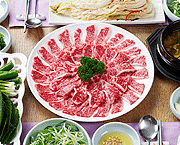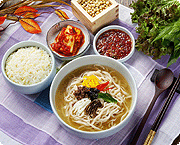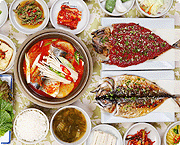Foods
Andong, the Capital of Korean Spirit

-
Andong JJimdak(Steamed chicken)
Drive you crazy with fantastic taste
Andong jjimdak is a variety of jjim (a Korean steamed or braised dish), made with chicken, various vegetables marinated in a ganjang (Korean soy sauce) based sauce. The name literally means "steamed chicken of Andong." There are many speculations on the origin of the dish. One is that the it is a specialty food of the inner rich village of Andong during the Joseon period, prepared and eaten for special occasions. Another assumptions is that during the 1980s in the Dak golmok ( literally "chicken alley") of the "Andong Old Market," restaurant owners there made a dish including ingredients that regulars demanded, which became the current Andong jjimdak. The most plausible speculation among existing assumptions is that merchants of the Dak golmok at the market created the dish to keep their position against the rapid expansion of Western fried chicken shops. You can have fresh and finest beef in Andong. Andong cow has been grow in cleanest environment. There are many beef special restaurants in Andong. Please visit the Andong Kalbi street. Also during the Andong Maskdance festival there is a event holding called Andong beef bulgogi event.

-
Andong Korean native cattle
The original korean beef, Only at the Andong!
you can have fresh and finest beef in Andong. Andong cow has been grow in cleanest environment. There are many beef special restaurants in Andong. Please visit the Andong Kalbi street. Also during the Andong mask dance festival there is a event holding called Andong beef bulgogi event.

-
Andong guksoo(Noodle)
It is called Andong Guksi by local slang
This noodle made by wheat flour and bean flour with noodles in a light broth made with green fish. It is served with a sauce made with sesame oil, soy sauce, scallions and a small amount of chili pepper powder. Thinly sliced jidan, or fried egg, gim, and zucchini are topped on the dish for garnish.

-
Heotjesabap
Heotjesa bap, (also spelled hutjesa bap) a traditional Korean dish, is a variety of bibimbap, served with soy sauce (ganjang) instead of the gochujang (hot pepper paste) that is more commonly used. Hutjesa bab consists of mainly several types of namul (young sprouted vegetables) over white rice. It is also served with grilled fish and some jeon (Korean pancake). The dish originated in Andong, Gyeongsangbuk-do, a famous place where scholars lived and studied during the Joseon Dynasty. The term, Heotjesa bap literally means "dishes for fake jesa" that are ceremonies for death anniversary and ancestor veneration held in Korea. It is said that as there was insufficient foods during the period, some scholars in yangban class living in the region prepared ceremonial foods for fake jesa and enjoyed the dishes as well as commoners did.

-
Andong salted mackerel
The nice taste of Andong salted Mackerel is Surprising!
Why don't you try them? It's the taste of the long tradition and of the home, Andong. There are many way to enjoy the mackerel like boiled down in soy sauce or other seasonings or baked with seasonings.





